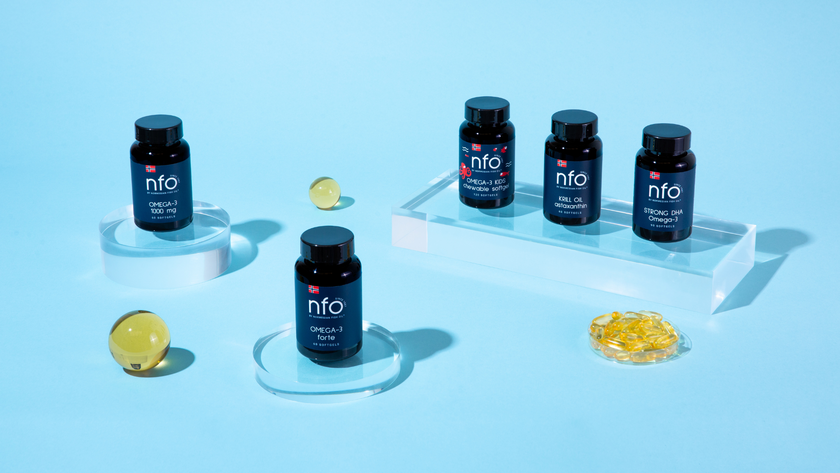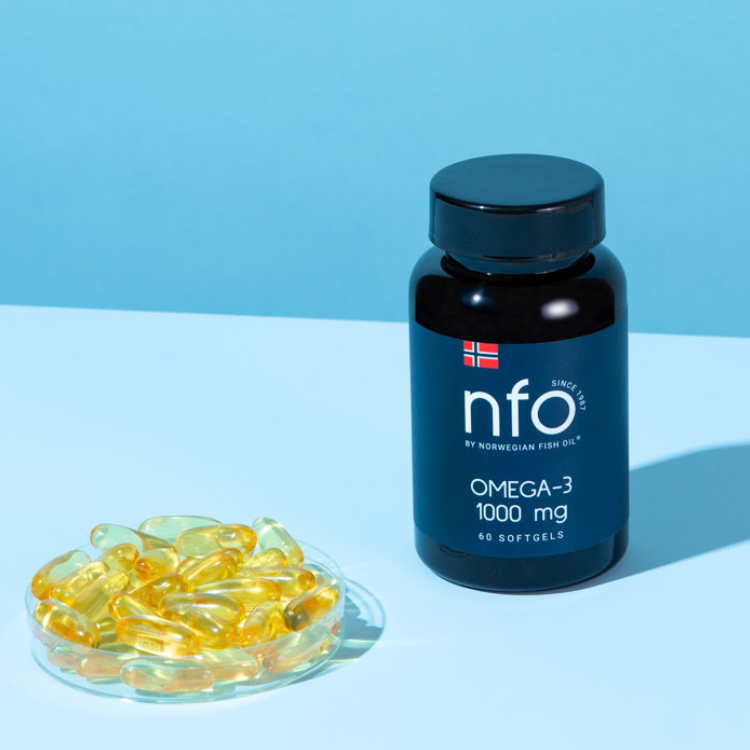Improved heart health in 120 days
One of the most significant changes you may experience in 120 days of daily omega-3 and magnesium supplementation is better cardiovascular health. Omega-3 fatty acids are well-known to improve blood lipid profiles. In fact, a 2023 meta-analysis of 90 clinical trials demonstrated that omega-3 intake produces a near-linear reduction in triglyceride levels. Lower triglycerides, along with modest increases in “good” HDL cholesterol, contribute to a healthier blood lipid profile and reduced risk of atherosclerosis. Omega-3s also can lower blood pressure and resting heart rate, prevent arrhythmias, and reduce inflammation in arteries, all of which protect your heart. Over about 4 months, as your red blood cell membranes become enriched with omega-3 (the Omega-3 Index reflects roughly the last 3–4 months of intake), you are likely to see measurable improvements in these cardiovascular risk factors.
Magnesium is likewise crucial for heart health. This mineral helps regulate blood pressure and heart rhythm and is involved in over 300 enzymatic reactions, including those that keep your heart muscle functioning properly. After 120 days of correcting a low magnesium intake, you may find that your blood pressure trends a bit lower or becomes easier to control, since magnesium aids blood vessel relaxation. In fact, population studies have found that people who get enough magnesium have significantly lower risks of heart disease and even cardiac death. For example, a large cohort study of post-heart-attack patients in the Netherlands found that those with higher magnesium intakes had a 28% lower risk of cardiovascular mortality compared to those with the lowest intakes. Getting at least the recommended ~300–400 mg of magnesium daily (from diet plus supplements) is important for maintaining healthy blood pressure and heart rhythm.
The Omega-3 and magnesium synergy: emerging research suggests that these two nutrients may reinforce each other for heart protection. Magnesium deficiency might actually weaken the heart benefits of omega-3s. This makes sense, because while omega-3s reduce triglycerides and inflammation, magnesium helps maintain normal heart rhythm and blood flow. Together, after months of combined supplementation, you may achieve more robust improvements – for instance, better cholesterol/triglyceride levels from omega-3 alongside more stable blood pressure from magnesium. Both nutrients also help calm the cardiovascular system (omega-3s improve arterial flexibility and reduce resting heart rate, and magnesium prevents arterial spasms). After 120 days, many people taking both report improvements like reduced palpitations, lower blood pressure readings, or improved exercise endurance due to better cardiovascular efficiency. It is no wonder these supplements are often recommended together for heart health support.
Enhanced brain function and mood support
Omega-3 fatty acids and magnesium are a powerful duo for your brain and mental well-being. After four months of consistent intake, you might notice sharper cognitive function, a more stable mood, and less stress. DHA, one of the main omega-3s in fish oil, is a major structural component of brain cell membranes – it literally helps build and repair brain cells. Adequate DHA and EPA (another key omega-3) have been linked to better memory, learning, and overall cognitive performance. Over 120 days, as omega-3 levels rise in your neurons, your brain may function more efficiently. Some studies even suggest that higher omega-3 intake is associated with a lower risk of age-related cognitive decline and Alzheimer’s disease. While those long-term effects take years, within a few months people often report improved focus and mental clarity, especially if their diet was low in omega-3 before.
Another big change is in mood and mental health. Both omega-3 and magnesium have well-documented benefits for depression, anxiety, and stress regulation. Omega-3 fatty acids are known to have an antidepressant effect: a meta-analysis found that omega-3 supplementation significantly improved depressive symptoms in people with depression (particularly formulas high in EPA). There is also evidence that omega-3s may help reduce anxiety. A systematic review in JAMA reported that omega-3 supplements were associated with reduced anxiety symptoms in clinical populations. The reasons are thought to include omega-3’s anti-inflammatory effects in the brain and their role in serotonin and dopamine neurotransmission. After 4 months of taking omega-3, you might feel a lift in your overall mood or less frequent anxious feelings, especially if you had low intake of fatty fish before.
Magnesium is sometimes called “nature’s chill pill” due to its calming effects on the nervous system. It helps regulate neurotransmitters (such as GABA and glutamate) that influence anxiety and mood. If you struggle with stress or anxious moods, magnesium supplementation can start making a difference within a few weeks. One clinical trial found that taking 248 mg of magnesium daily for just 6 weeks led to a significant improvement in depression and anxiety scores in adults with mild-to-moderate depression. Participants noticed results as early as two weeks into magnesium therapy. By the 120-day mark, magnesium’s cumulative effects often include feeling less stressed, sleeping better (more on that later), and improved emotional resilience. Magnesium is also being studied as an adjunct for clinical anxiety; while more research is needed, some evidence suggests it can help ease anxiety, especially in people who are deficient.
Importantly, omega-3 and magnesium together may offer synergistic brain benefits. Deficiency in either nutrient is associated with higher risk of depression and poor cognitive performance. Ensuring you have both means your brain has the tools it needs to maintain neurotransmitter balance, reduce inflammation, and support neuroplasticity. After several months, people often report improvements in concentration and memory (thanks in part to omega-3’s role in brain cell structure) alongside a calmer, happier mindset (thanks to magnesium’s and omega-3’s combined mood-stabilizing roles). For general wellness readers, this means that 120 days of these supplements might leave you feeling mentally sharper and emotionally more balanced than you did before.
Reduced inflammation, pain relief, and joint health
Chronic inflammation is at the root of many aches, pains, and long-term health issues – and omega-3 plus magnesium is a powerful anti-inflammatory combo. By the 3-4 month mark of supplementation, significant reductions in inflammation can occur, which you may notice as less joint pain, fewer headaches, or quicker post-workout recovery.
Omega-3 fatty acids have well-established anti-inflammatory properties. They interfere with the production of inflammatory molecules (like certain prostaglandins and leukotrienes) and instead serve as building blocks for resolvins and protectins – specialized compounds that actively resolve inflammation. If you have an inflammatory condition such as arthritis, this is where omega-3 shines. Studies show that fish oil (rich in EPA/DHA omega-3) can improve symptoms of rheumatoid arthritis, for example. In multiple clinical trials, patients who took fish body oil for about 3 months experienced significantly fewer tender joints and reduced morning stiffness compared to placebo. Many were even able to cut down on NSAID pain relievers thanks to fish oil’s effect. So after 120 days of omega-3 supplements, you might notice your joints feeling less creaky or swollen if you had issues, or generally fewer inflammatory flares. Omega-3s may also help with exercise-induced inflammation: some research found omega-3 supplementation lowered markers of muscle damage and soreness after workouts, potentially helping you recover faster.
Magnesium contributes to inflammation control as well. Magnesium intake is inversely associated with levels of C-reactive protein (CRP), a key inflammatory marker. In fact, a meta-analysis found that magnesium supplementation can significantly reduce CRP levels, especially in individuals who had high CRP to begin with. Essentially, magnesium calms the immune system and helps prevent the excessive inflammatory response that underlies conditions like metabolic syndrome and arthritis. Clinically, magnesium is sometimes used to help with muscle cramps and migraines – both of which have inflammatory components. By 120 days, consistent magnesium should have repleted your body’s stores (particularly if you were deficient), and you may experience fewer muscle spasms or tension headaches. Magnesium aids muscle relaxation and prevents the buildup of certain pain-causing substances. For example, magnesium malate (a form of magnesium bound to malic acid) has been studied for fibromyalgia and muscle pain relief; it may improve muscle energy production and reduce tenderness in muscles over time.
Together, omega-3 and magnesium can provide natural pain relief. Omega-3’s resolvins help “turn off” the inflammatory response once healing should begin, while magnesium’s muscle-relaxing and nerve-calming effects alleviate tension. After a few months on this regimen, people with chronic pain conditions often report a noticeable decrease in pain severity. Even if you do not have a diagnosed condition, you might find you get fewer inflammatory ailments like eczema flares or seasonal aches. The 4-month mark is a realistic timeframe to gauge these changes, since by then cell membranes throughout your body have been remodeled to include more omega-3 (making your cells less prone to inflammation) and intracellular magnesium is optimized for hundreds of enzymes. Scientific reviews conclude that ensuring sufficient omega-3 and magnesium in the diet or through supplements can lower systemic inflammation and might even improve markers in diabetes and heart disease patients. This means better overall long-term health, with the short-term perk of feeling less pain and stiffness day-to-day.
Better sleep quality and stress reduction
Another area where people often see improvements after a few months of omega-3 and magnesium is sleep and stress management. If you struggle with insomnia, poor sleep quality, or high stress levels, these supplements could lead to noticeable benefits by the 120-day point.
Magnesium is well-known as a sleep aid – many people take magnesium (especially forms like magnesium glycinate) in the evening to help them relax. Magnesium helps activate the parasympathetic nervous system (your “rest and digest” mode) and binds to GABA receptors in the brain, promoting calm and relaxation. Magnesium glycinate, in particular, is prized for its calming properties; it’s magnesium chelated with the amino acid glycine, which itself has sedative effects. This form is frequently used to improve sleep quality and has excellent bioavailability with minimal digestive upset. In one clinical study on older adults with insomnia, 8 weeks of magnesium supplementation improved sleep time, sleep efficiency, and helped people fall asleep faster. By 120 days, you can expect even more solidified improvements in sleep patterns – many users report deeper sleep and fewer night-time awakenings once their magnesium levels are repleted. Additionally, magnesium’s anxiety-reducing effect (discussed earlier) means that racing thoughts or stress hormones at night are tempered, making it easier to unwind at bedtime. It is not uncommon to hear someone say, “I didn’t realize how much magnesium was helping my sleep until I ran out of it!” – indicating that after months of supplementation, it became integral to their nightly rest.
Omega-3s, surprisingly, also play a role in sleep. Recent research has drawn connections between omega-3 (especially DHA) status and the body’s ability to produce melatonin, the hormone that regulates sleep-wake cycles. Low levels of DHA have been linked to melatonin deficiencies, while increasing DHA (through diet or supplements) has been shown to raise melatonin levels. In practical terms, this means that after a few months of boosting your omega-3 intake, your body might secrete more melatonin at night, helping you fall asleep naturally. One study of healthy men found that eating fatty fish three times a week for several months led to better sleep quality and faster onset of sleep at bedtime. The omega-3/vitamin D combo in fish likely contributed, but it underscores that omega-3-rich diets improve sleep. Omega-3s also reduce inflammation and cortisol (a stress hormone), which can indirectly improve sleep by creating a calmer internal environment.
By 120 days of combined omega-3 and magnesium use, you may experience more restful nights and calmer days. Many people report that they not only fall asleep quicker, but also wake up feeling more refreshed. Your circadian rhythm can stabilize as melatonin normalization kicks in from omega-3 DHA. Meanwhile, magnesium’s regulation of stress hormones means you might handle daily stressors more gracefully and avoid that “wired and tired” feeling at night. Scientific reviews have concluded that maintaining optimal levels of both omega-3 and key micronutrients like magnesium supports healthy sleep regulation. So, if you are someone who started these supplements hoping for more energy and less stress, better sleep is a huge part of that equation – and it often becomes apparent by the 3–4 month mark.
Metabolic boost and energy levels
When taken together for several months, omega-3 and magnesium can also positively influence your metabolic health and energy levels. These effects might be subtler than the big changes in heart or brain health, but they are still significant for overall wellness.
Omega-3 fatty acids have been shown to improve certain metabolic parameters. For one, they can enhance your body’s ability to burn fat and even slightly raise your metabolic rate. A study in young adults found that 12 weeks (about 3 months) of fish oil supplementation led to a 14% increase in resting metabolic rate, as well as a 10% increase in the number of calories burned during exercise. The participants also saw improved muscle efficiency. By 120 days, you may notice that you have a bit more stamina during workouts or that weight management is a little easier – these subtle changes come from omega-3’s effect on cell membranes and fat metabolism. Additionally, omega-3s can improve insulin sensitivity and reduce liver fat in people with non-alcoholic fatty liver disease, contributing to healthier blood sugar levels over time. While you might not feel insulin sensitivity improvements directly, your annual lab tests (like fasting glucose or triglycerides) could show better numbers after months on omega-3.
Magnesium is a star player in metabolic health as well. It is required for insulin to function properly and for cells to take up glucose efficiently. If you were magnesium-deficient, you might have been experiencing symptoms like low energy, frequent fatigue, or even sugar cravings. After restoring magnesium over 4 months, many people report steadier energy throughout the day. This is partly because magnesium helps in ATP production – the creation of cellular energy. It is literally involved in the energy currency of your cells, so adequate magnesium can make your natural energy production more efficient. Moreover, research has shown that higher magnesium intake is associated with a lower risk of developing type 2 diabetes and metabolic syndrome. Over a few months, magnesium can improve blood sugar control in those with insulin resistance. One clinical trial noted that people with prediabetes who took magnesium supplements had improvements in fasting glucose and insulin metrics after 12 weeks, compared to placebo (especially if they had low magnesium status to start).
What does this mean for you after 120 days? You might find that you no longer hit that afternoon slump as hard as you used to. Your workouts might feel easier to power through, and post-exercise recovery might be faster (since both omega-3 and magnesium support muscle recovery and reduce oxidative stress). Some individuals also report mild weight loss or reduction in belly fat when combining omega-3 and magnesium with a healthy diet over several months – likely due to improved metabolic function and less systemic inflammation. While supplements are not magic diet pills, they create a healthier internal environment that can make lifestyle efforts more effective. For example, magnesium can help curb chocolate cravings and regulate appetite if those issues were tied to a deficiency. Omega-3, on the other hand, has been noted in some studies to increase satiety (feeling of fullness) and even boost the calorie burn slightly. By the end of four months, the metabolic uptick from these supplements, though modest, can contribute to feeling more vital and energetic overall.
Maximizing the benefits: choosing the right omega-3 and magnesium supplements
To fully enjoy the positive changes after 120 days, it’s important to choose quality supplements and the forms of each nutrient that suit your needs. Here are some tips:
-
Omega-3 supplements (fish oil): most omega-3 supplements come as fish oil capsules, providing EPA and DHA (the active omega-3 fatty acids). Aim for a fish oil that gives you around 1,000–2,000 mg of combined EPA+DHA per day, as higher doses in this range are what studies often use to achieve benefits like triglyceride reduction. Look for brands that are purified to remove mercury and PCBs (many will say “molecularly distilled” or “third-party tested for purity”). If you are vegetarian or vegan, algae-based omega-3 supplements can provide DHA and EPA as well. Fish oil is the most common choice – it is convenient and effective for raising your omega-3 index. One thing to note: it takes time (weeks to months) for these fatty acids to build up in your system. Do not be discouraged if you do not feel a big difference in the first few weeks. By day 120, your red blood cells should be loaded with EPA/DHA, and that is when the health effects really become apparent.
-
Magnesium supplements – forms matter: magnesium comes in many forms, and some are better absorbed (and more gentle on the stomach) than others. Magnesium glycinate (or bisglycinate) is a highly absorbed form bound to glycine. It is known for causing minimal gastrointestinal side effects – unlike some magnesium salts, it’s unlikely to cause diarrhea. Magnesium glycinate is also prized for its calming, sleep-promoting qualities, since glycine itself has a relaxing effect on the brain. This form is a great choice if you want to improve sleep or reduce anxiety while repleting magnesium. Magnesium citrate is another popular form; it is well-absorbed but does have a mild laxative effect (in fact, magnesium citrate is sometimes used to relieve constipation). If you struggle with regularity, this could be a bonus, but if not, just be aware that too much magnesium citrate might loosen your stools. Magnesium malate combines magnesium with malic acid, which is involved in energy production. This form is often recommended for muscle pain (like in fibromyalgia) and for enhancing physical energy. Some users find magnesium malate helps with muscle soreness and recovery after exercise. Other forms you might encounter include magnesium threonate (notable for cognitive effects), magnesium sulfate (Epsom salts, for baths or short-term use), and magnesium oxide (not very bioavailable, usually not the best choice for raising magnesium levels). The key is to pick a form that matches your goals and tolerances.
-
Dosage and consistency: for general wellness, a common magnesium dosage is around 200–400 mg of elemental magnesium per day (depending on how much you get from diet; always check the supplement label for how much elemental magnesium it provides). This aligns with the RDA (about 310–420 mg for adults). Many people take magnesium in the evening to aid sleep, but you can split the dose morning and night if you prefer. With omega-3, a standard dose is 1000 mg of fish oil (which typically contains ~300 mg EPA/DHA), but for noticeable benefits, doses of 1–3 grams of EPA+DHA are often used in studies. You might take 2–4 standard fish oil capsules daily to hit these targets, or use a concentrated fish oil. It is best to take fish oil with meals (especially a meal containing fat) to enhance absorption and reduce any fishy burps. Consistency is crucial: try to take your supplements every day. Remember, it takes time to build up levels – those 120 days of steady intake are what enable the transformations we discussed.
-
Safety notes: omega-3 and magnesium are generally very safe for most people, but a few precautions are worth noting. High doses of fish oil (over 3 grams of EPA/DHA per day) can have a blood-thinning effect, so if you are on blood thinners or have a bleeding disorder, consult your doctor to personalize your dose. Fish oil can occasionally cause mild side effects like fishy aftertaste or upset stomach; freezing the capsules or trying an enteric-coated brand can help. Magnesium supplements, if taken in excess, might cause diarrhea or stomach upset – this is your body’s way of shedding unabsorbed magnesium. If you experience this, try switching to a different form (like glycinate) or splitting the dose. Individuals with kidney disease should be cautious with magnesium supplements and only use them under medical supervision, since poor kidneys can have trouble eliminating excess magnesium. For most healthy people, magnesium overdose is rare because the kidneys excrete any extra. As always, it is wise to discuss with a healthcare provider before starting supplements, especially if you have underlying health conditions or take medications.
By choosing good-quality supplements and the right forms, you set yourself up for success – allowing that 120-day regimen to deliver maximal benefits. It’s also helpful to pair supplements with a nutrient-rich diet. Eating fatty fish (salmon, sardines, mackerel) along with your fish oil can further boost omega-3 levels, and consuming magnesium-rich foods (leafy greens, nuts, seeds, whole grains) will complement your magnesium supplement. This way, you are approaching that 4-month mark with your body fully loaded with these nutrients.
Conclusion
After 120 days of taking omega-3 and magnesium supplements, many people experience a notable positive shift in their overall wellness. Scientific studies and user reports alike highlight improvements in heart health (lower triglycerides, better blood pressure and circulation), brain function (sharper cognition and better mood), inflammation levels (reduced joint pain and muscle soreness), and sleep quality (deeper, more restorative sleep). These changes do not happen overnight – but that is exactly why the 3–4 month timeframe is so important. It allows your body to integrate the omega-3 fatty acids into cell membranes throughout your system and to correct any magnesium shortfall in your cells. In essence, 120 days is enough time to re-tune your body’s biochemistry in favor of health and equilibrium.
Perhaps just as importantly, taking omega-3 and magnesium together amplifies their individual benefits. They cover for each other’s gaps: omega-3 fights inflammation and protects your heart and brain, while magnesium supports the electrical rhythm of your heart, the firing of your neurons, and the relaxation of your muscles. It is a nutritional tag-team that leaves you feeling more energetic yet calm, strong yet limber. And for general wellness readers, the takeaway is empowering – these are natural nutrients that our bodies recognize and need. Over a few months, filling up on them can transform subtle deficits into vibrant health benefits.
Keep in mind that individual results can vary based on your starting point. If you had a serious omega-3 deficiency or magnesium deficiency, you might feel dramatic improvements in things like mood or fatigue. If you were already well-nourished, the changes might be more subtle but still meaningful (perhaps your blood test numbers improve or you recover from workouts faster). Either way, science backs the long-term use of omega-3 and magnesium for sustaining health. And at the 120-day milestone, you will have given these supplements enough time to show you what they can do. So, if you are about to start (or are in the early stages), stay consistent and be patient – your body in four months will thank you for the daily investment you are making in omega-3 fatty acids and magnesium.









